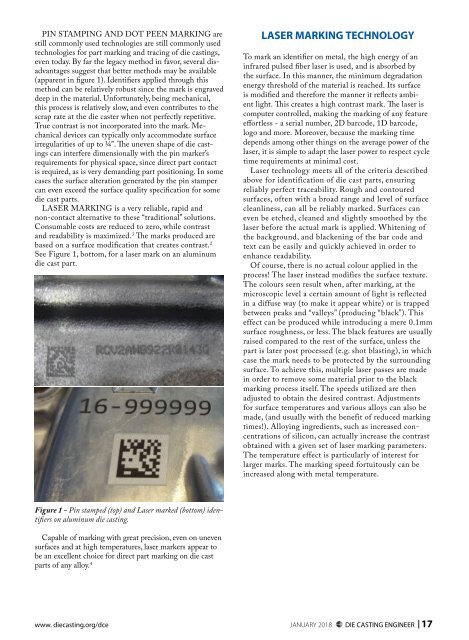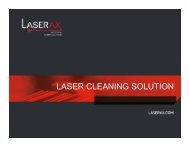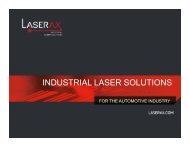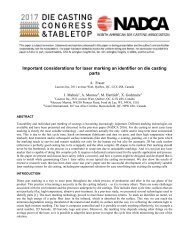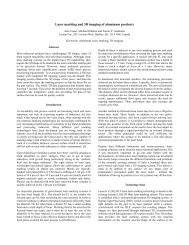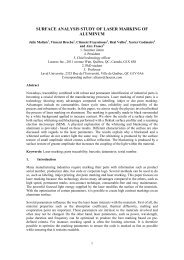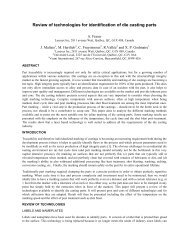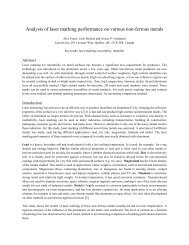Traceability and Laser Marking of Die Castings
Part traceability is increasingly required not just for safety critical applications, but also for a growing number of applications along the aluminum entire value chain. In this white paper, you will learn about laser direct part marking on diecasting and its resistance to post process treatments.
Part traceability is increasingly required not just for safety critical applications, but also for a growing number of applications along the aluminum entire value chain. In this white paper, you will learn about laser direct part marking on diecasting and its resistance to post process treatments.
You also want an ePaper? Increase the reach of your titles
YUMPU automatically turns print PDFs into web optimized ePapers that Google loves.
PIN STAMPING AND DOT PEEN MARKING are<br />
still commonly used technologies are still commonly used<br />
technologies for part marking <strong>and</strong> tracing <strong>of</strong> die castings,<br />
even today. By far the legacy method in favor, several disadvantages<br />
suggest that better methods may be available<br />
(apparent in figure 1). Identifiers applied through this<br />
method can be relatively robust since the mark is engraved<br />
deep in the material. Unfortunately, being mechanical,<br />
this process is relatively slow, <strong>and</strong> even contributes to the<br />
scrap rate at the die caster when not perfectly repetitive.<br />
True contrast is not incorporated into the mark. Mechanical<br />
devices can typically only accommodate surface<br />
irregularities <strong>of</strong> up to ¼”. The uneven shape <strong>of</strong> die castings<br />
can interfere dimensionally with the pin marker’s<br />
requirements for physical space, since direct part contact<br />
is required, as is very dem<strong>and</strong>ing part positioning. In some<br />
cases the surface alteration generated by the pin stamper<br />
can even exceed the surface quality specification for some<br />
die cast parts.<br />
LASER MARKING is a very reliable, rapid <strong>and</strong><br />
non-contact alternative to these “traditional” solutions.<br />
Consumable costs are reduced to zero, while contrast<br />
<strong>and</strong> readability is maximized. 3 The marks produced are<br />
based on a surface modification that creates contrast. 2<br />
See Figure 1, bottom, for a laser mark on an aluminum<br />
die cast part.<br />
LASER MARKING TECHNOLOGY<br />
To mark an identifier on metal, the high energy <strong>of</strong> an<br />
infrared pulsed fiber laser is used, <strong>and</strong> is absorbed by<br />
the surface. In this manner, the minimum degradation<br />
energy threshold <strong>of</strong> the material is reached. Its surface<br />
is modified <strong>and</strong> therefore the manner it reflects ambient<br />
light. This creates a high contrast mark. The laser is<br />
computer controlled, making the marking <strong>of</strong> any feature<br />
effortless - a serial number, 2D barcode, 1D barcode,<br />
logo <strong>and</strong> more. Moreover, because the marking time<br />
depends among other things on the average power <strong>of</strong> the<br />
laser, it is simple to adapt the laser power to respect cycle<br />
time requirements at minimal cost.<br />
<strong>Laser</strong> technology meets all <strong>of</strong> the criteria described<br />
above for identification <strong>of</strong> die cast parts, ensuring<br />
reliably perfect traceability. Rough <strong>and</strong> contoured<br />
surfaces, <strong>of</strong>ten with a broad range <strong>and</strong> level <strong>of</strong> surface<br />
cleanliness, can all be reliably marked. Surfaces can<br />
even be etched, cleaned <strong>and</strong> slightly smoothed by the<br />
laser before the actual mark is applied. Whitening <strong>of</strong><br />
the background, <strong>and</strong> blackening <strong>of</strong> the bar code <strong>and</strong><br />
text can be easily <strong>and</strong> quickly achieved in order to<br />
enhance readability.<br />
Of course, there is no actual colour applied in the<br />
process! The laser instead modifies the surface texture.<br />
The colours seen result when, after marking, at the<br />
microscopic level a certain amount <strong>of</strong> light is reflected<br />
in a diffuse way (to make it appear white) or is trapped<br />
between peaks <strong>and</strong> “valleys” (producing “black”). This<br />
effect can be produced while introducing a mere 0.1mm<br />
surface roughness, or less. The black features are usually<br />
raised compared to the rest <strong>of</strong> the surface, unless the<br />
part is later post processed (e.g. shot blasting), in which<br />
case the mark needs to be protected by the surrounding<br />
surface. To achieve this, multiple laser passes are made<br />
in order to remove some material prior to the black<br />
marking process itself. The speeds utilized are then<br />
adjusted to obtain the desired contrast. Adjustments<br />
for surface temperatures <strong>and</strong> various alloys can also be<br />
made, (<strong>and</strong> usually with the benefit <strong>of</strong> reduced marking<br />
times!). Alloying ingredients, such as increased concentrations<br />
<strong>of</strong> silicon, can actually increase the contrast<br />
obtained with a given set <strong>of</strong> laser marking parameters.<br />
The temperature effect is particularly <strong>of</strong> interest for<br />
larger marks. The marking speed fortuitously can be<br />
increased along with metal temperature.<br />
Figure 1 - Pin stamped (top) <strong>and</strong> <strong>Laser</strong> marked (bottom) identifiers<br />
on aluminum die casting.<br />
Capable <strong>of</strong> marking with great precision, even on uneven<br />
surfaces <strong>and</strong> at high temperatures, laser markers appear to<br />
be an excellent choice for direct part marking on die cast<br />
parts <strong>of</strong> any alloy. 4<br />
www. diecasting.org/dce JANUARY 2018 1DIE CASTING ENGINEER | 17


